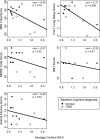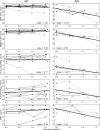Amyloid imaging and cognitive decline in nondemented oldest-old: the 90+ Study
- PMID: 23164550
- PMCID: PMC3604036
- DOI: 10.1016/j.jalz.2012.06.005
Amyloid imaging and cognitive decline in nondemented oldest-old: the 90+ Study
Abstract
Background: The goal of this study was to examine cross-sectional and longitudinal associations between cognitive performance and beta amyloid (Aβ) load determined by florbetapir F18 positron emission tomography (PET) in nondemented oldest-old.
Methods: Thirteen nondemented (normal or cognitively impaired nondemented) participants (median age, 94.2 years) from The 90+ Study underwent florbetapir-PET scanning within 3 months of baseline neuropsychological testing. Amyloid load was measured with a semi-automated quantitative analysis of average cortical-to-cerebellar standardized uptake value ratio (SUVr) and a visual interpretation (Aβ- or Aβ+). Neuropsychological testing was repeated every 6 months.
Results: At baseline, SUVr correlated significantly with tests of global cognition and memory. During follow-up (median, 1.5 years), the Aβ+ group had steeper declines on most cognitive tests, particularly global cognitive measures.
Conclusion: This preliminary study suggests that greater amyloid load is associated with poorer cognition and faster cognitive decline in nondemented oldest-old. Amyloid load may identify individuals at increased risk of developing Alzheimer's disease.
Copyright © 2013 The Alzheimer's Association. Published by Elsevier Inc. All rights reserved.
Figures


References
-
- Klunk WE, Engler H, Nordberg A, et al. Imaging brain amyloid in Alzheimer's disease with Pittsburgh Compound-B. Annals of neurology. 2004;55:306–319. - PubMed

